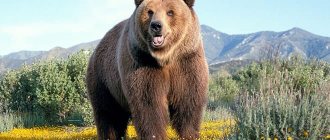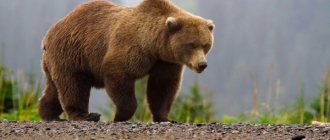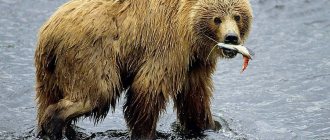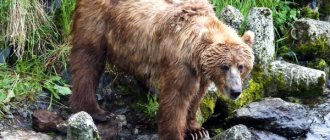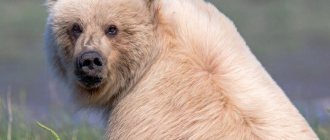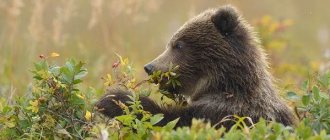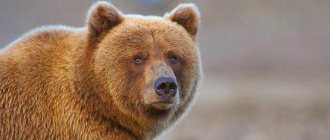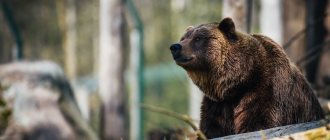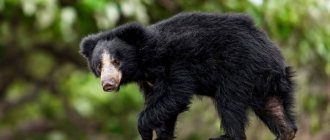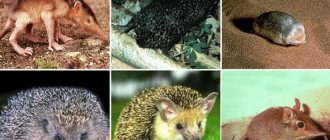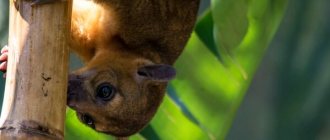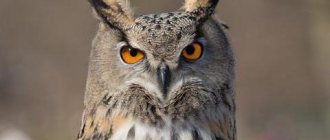Brown bears appeared in Eurasia approximately 50,000 years ago. Some of them moved to North America, where they spread and live for about 13,000 years. In the 19th century, scientists classified 86 distinct species of grizzly bears found on the North American continent. However, by 1928 the scientific community had narrowed the number to seven, and by 1953 only one species had been recognized.
In 1963, it became clear that the grizzly bear is not a separate species, but a subspecies of the brown bear, and this was confirmed by modern genetic testing. Based on external differences and habitat, several of its subspecies were identified, but the classification was revised along genetic lines, and today there are two morphological forms: the continental and coastal grizzly bear. In scientific sources it is usually called the North American brown bear.
External features
Like other subspecies of brown bear, the brown coat color of the grizzly bear can range from light beige to almost black. The latter has a darker coat color on the legs and a lighter shade on the back. Representatives of the Rocky Mountains have white tips on their guard coats, which gives the animal a grayish coloration.
The external signs of a grizzly bear and a brown bear have a number of characteristic features. As the animals mature, a clearly defined hump develops at the withers, which is a good way to distinguish a grizzly bear from a black bear that lives in the same area. Small rounded ears and a croup located below the shoulder line are anatomical structures that are also distinctive for the brown bear and not inherent in the black bear. These two species are also distinguished by the length of the front claws, which in the black representative is 2.5-5 cm, and in the grizzly it is about 5-10 cm, which corresponds to the size of the claws of other subspecies of brown bear.
Characteristics of the animal
In terms of the structure of its body, the grizzly bear is very similar to its East Siberian relative. Such a bear has a very impressive large size - from 450 kilograms and above . It prefers to live on the coast and mostly feeds on salmon fish. Those individuals that are found in the forest are vegetarians and scavengers.
The size of the animal, the color of its coat and its lifestyle determine the conditions in which it constantly lives.
Size and weight
The main difference between the grizzly bear and the Eurasian brown bear is size and weight. Coastal representatives of the species are larger than those that live in the interior of the continent, and just like all of the bear family, females are smaller than males. Most adult female bears reach 130-180 kg, and males usually weigh 180-360 kg; newborn cubs do not exceed 500 grams. The average weight of coastal grizzlies is 408 kg for males and 227 kg for females. The corresponding weights of continental bears are 272 and 227 kilograms.
Average sizes of the subspecies:
- length -198 cm;
- height at withers -102 cm;
- the length of the hind legs is 28 cm.
However, individuals have been recorded that are significantly larger than normal in size and weight. There is a known example of the largest grizzly bear - a coastal male weighing 680 kg and 1.5 meters high at the withers. Standing on its hind legs, this bear reached almost three meters in height. Sometimes there are superior sizes and weights of grizzlies, but they are erroneous, since they correspond to the parameters of the Kodiak, another larger subspecies of brown bear.
Brown bear
A brown or common bear is usually called a large-sized predatory animal belonging to the bear family.
In ancient times, the brown bear lived throughout the European continent; it could also be seen in a number of Asian countries (China, Japan).
Brown bear
Today it is found in the Scandinavian countries (Scandinavia, Norway), in the western part of Europe (Pyrenees, Alps, Apennines), in Finland, the Carpathians, Russia, Japan, China, the Korean Peninsula and so on. In Finland, this animal has sacred status.
Today there are about 80 subspecies of this animal, among which the most famous are:
- Siberian brown bear.
- Apennine.
- Tien Shan.
- Japanese.
- Grizzly.
- Kodiak.
- Tibetan and so on.
Siberian brown bear
Range and numbers
In North America, grizzlies once lived from Alaska to Mexico. Now, including Canada and the United States, their range has been halved, and the number of wild bears is 55,000. Grizzly bear habitats are limited to Alaska, a large area of western Canada, the northwestern United States including Idaho, Washington, Montana, and Wyoming, as far south as Yellowstone and the Great National Parks.
Most of the population lives in Alaska. There is a predominant number of bears recorded in Canada: about 25,000 individuals inhabit British Columbia, Alberta, Yukon, the northwest territories of Nunavut and northern Manitoba. The University of Alberta estimates that there were 16,014 grizzly bears in British Columbia in 2008, up from 15,075 in 2012. Modern population estimates rely on DNA sampling, capture-recapture techniques, and an improved multiple regression model.
There are about 1,500 grizzly bears left in the United States. Of these, approximately 800 individuals live in Montana, 600 bears live in the Yellowstone-Teton region of Wyoming, and 70-100 are observed in northern and eastern Idaho.
Relationship with a person
The American pioneers, who described the grizzly bear as a harsh and ferocious animal, constantly thirsting for human blood, clearly embellished their stories, as a result of which people had an erroneous idea about the bear.
A bear will never consider a person as its potential prey, unless this same person openly attacks him, or the animal experiences extreme hunger.
Farmers throughout the 19th century, as well as at the very beginning of the 20th century, actively exterminated the grizzly bear population, thereby trying, according to them, to protect their livestock from attacks. Many animals were killed as trophies.
Currently protected by the US federal government, the grizzly bear lives mostly in national parks.
Population decline
The original range of the grizzly bear in the United States included the Great Plains and much of the southwestern states, but the population has been extirpated from most of these areas. Before California joined the United States, its state flag featured the figure of a California grizzly bear, which was a symbol of the republic. The last bear in all of California was killed in the Sierra foothills in August 1922. In Colorado, the last representative was seen in 1979. And in the vast Cascade Mountains of Washington state, there are now fewer than 20 grizzly bears.
The population decline has been significantly impacted by hunting and human developments occupying the grizzly bear's former habitats. Other factors:
- competition with other, more adapted predators;
- attacks on grizzly bear cubs;
- reproductive, biological and behavioral properties of brown bears.
Lifestyle and reproduction
Apart from females with cubs, all brown bears are solitary animals. An exceptional feature of large grizzly bears in coastal North America is to gather in groups near streams, lakes and rivers during salmon spawning season. Each adult male grizzly bear tends his personal property with an area of up to 4000 km2. Such a large territory and low population make it very difficult to find the scent of a female. The grizzly bear hibernates 5-7 months a year.
The grizzly bear has one of the lowest reproductive rates of any land mammal in North America. Animals reach sexual maturity only at the age of at least five years. After the summer mating season, the female may delay embryo implantation until hibernation, which explains the large difference in gestation periods - from 180 to 250 days. If the bear does not receive proper nutrition, the necessary calories and substances, then the embryo is miscarried.
Litter size ranges from one to four cubs, but more often twins or triplets are born, which the female produces during hibernation. The female bear takes care of the cubs for two years, during which she does not mate. Often bear cubs do not live to this age, becoming victims of predators. During the time spent with their mother, the cubs gain weight up to 45 kg. When two-year-old bears leave their mother, the mother bear cannot produce another litter for three or more years, depending on environmental conditions.
Nutrition
After the end of hibernation, the bear begins to intensively search for food. These representatives of the order of predators are omnivores. Gray bears prefer plant foods.
Their main food: young shoots, nuts, berries, tree fruits, algae and roots. Bird eggs, insects and their larvae, as well as reptiles are used as delicacies. In just one day, a grizzly bear can absorb up to 40 thousand butterflies.
Carrion is also grizzly bear food. The animal can smell its scent at a distance of 30 km. A deer killed by a bear provides it with food for a week. However, the animal prefers to hunt sick, weak or young animals.
It is a delicacy for grizzlies. During the spawning season, salmon gather in groups on the shore and distribute fishing zones among themselves. They catch fish with their mouths or with the help of wide paws. Some bears manage to grab it on the fly when it jumps out of the water.
Bear cubs, who have a sweet tooth, mainly indulge in honey, because at a young age they can climb a tree. Before hibernation, the bear begins to experience polygapia - a feeling of constant hunger. This is understandable, since before going to bed you need to gain as much fat as possible.
To do this, the animal must eat 20 thousand calories daily. After a good meal the animal rests. It secludes itself in gorges or temporary housing, which is lined with grass.
Lifespan
The grizzly bear is a long-living animal. Males, on average, live up to 22 years, and the age of female bears often exceeds 26 years. Females live longer than males due to safer behavior and the fact that they do not participate in seasonal mating fights between males. The oldest continental wild grizzly bear was recorded in Alaska; he lived for 34 years. The oldest coastal bear lived to be 39 years old. At least 50% of captive grizzlies live to be 44 years old. But most bears die in the first years of life from predators or hunting.
Attacks on people
Like the polar bear, the grizzly bear is considered more aggressive than other species. However, threatening behavior is more often due to the protection of offspring. Mother bears guarding cubs are most prone to attack. They are responsible for 70% of cases of bear attacks on humans. At the same time, the heavy grizzly bear is rather slow and, unlike smaller black bears, does not climb trees well, and prefers to react to danger by standing still and driving away attackers with waves of its paws, growls and menacing nods of the head.
Cardall and Peter Rosen's article "Grizzly Bear Attacks," published in the journal Emergency Medicine, noted that there were 162 reported bear injuries, some fatal, in the United States from 1900 to 1985. This amounts to approximately two cases per year. For comparison: in the USA and Canada, up to 15 people die annually from dog attacks, and lightning strikes kill nearly 90 people per year.
